Trijicon RCR Pros & Cons
Pros
- 6 year battery life
- Extremely durable
- Enclosed emitter
Cons
- Price
The Bottom Line
The RCR is a very rugged, enclosed emitter red dot that has all the features you need, none that you don’t, and will cost you a pretty penny.
In August 2023, Trijicon announced a new red dot to the shooting community called the RCR—Ruggedized Closed Reflex — capitalizing on the growing demand for enclosed emitter optics.
Basing it on the footprint of their Ruggedized Miniature Reflex (RMR), Trijicon sought to establish yet another benchmark in pistol optics. Would they be able to match that quality or even improve upon the original?
Trijicon sent us one to test so we could answer that question, but strap in — the sticker shock is real!
Table of Contents
Loading…
Prices accurate at time of writing
Prices accurate at time of writing
-
25% off all OAKLEY products - OAKLEY25
Copied! Visit Merchant
How We Tested the Trijicon RCR
I mounted the RCR to a Gen 4 Glock 17 and took it to the range, where I fired approximately 500 rounds of 9mm AAC 115gr. In addition, I used some Hornady Critical Duty 124gr to test defensive rounds.
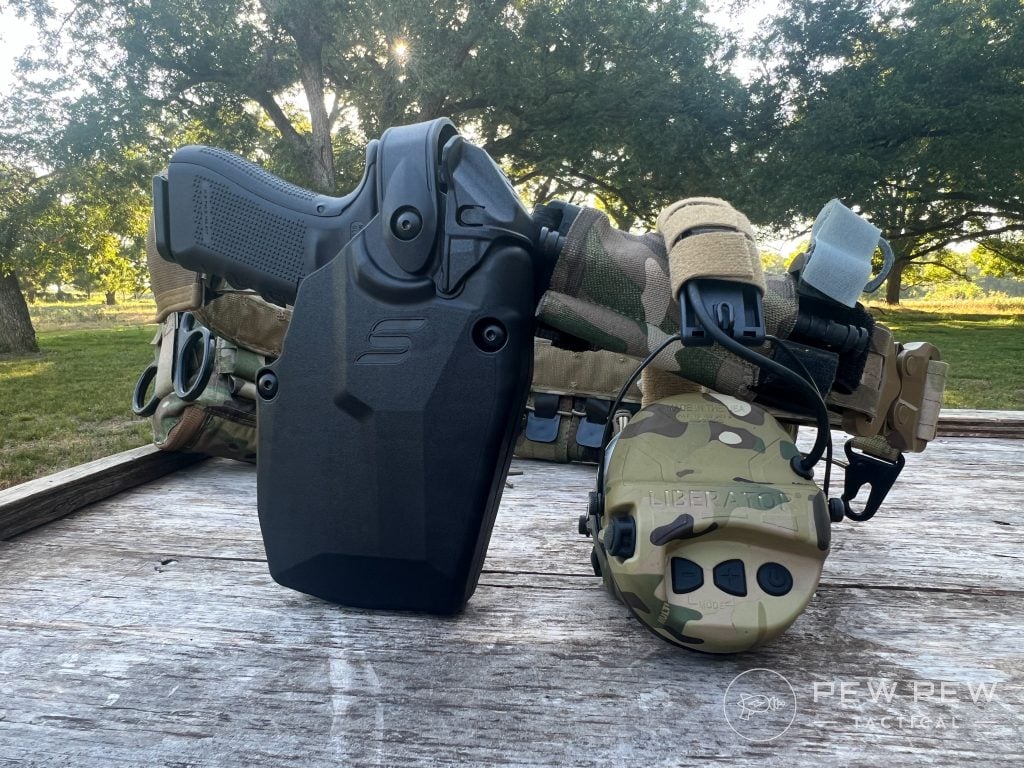
Conditions were hot (high temperature of 109) and bright, with no cloud cover, though low-light testing was conducted indoors. As this was a loaner optic, I did not torture test the RCR.
For the review, I used a Safariland SafariVault holster. It should be noted that the RCR’s size makes it incompatible with some holsters, though Trijicon has a list of working options here.
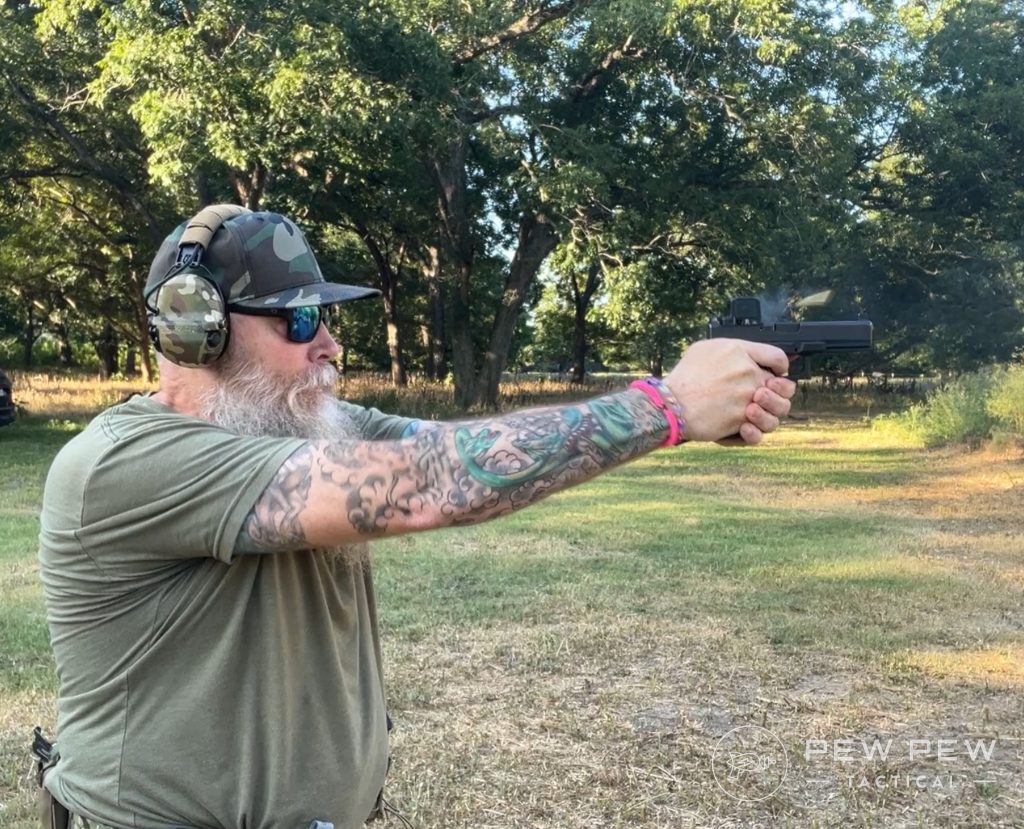
For background, I’ve been shooting since childhood but really began to delve into guns more during my law enforcement career of over two decades. I received continued training for my roles in SWAT and was a POST-certified handgun instructor.
Trijicon RCR Specs
- Weight: 1.95 oz. (with battery)
- Battery Life: Over six years on brightness setting 5 of 10
- Illumination Settings: 10 settings (3 night vision, 1 super bright)
- Dot Size: 3.25 MOA
- Objective Lens: .88 x .64”
- Waterproof: 66’
- Footprint: Trijicon RMR
- Battery: CR2032
- Price: $645
Trijicon RCR Features
Trijicon has clearly listened to its customers and implemented features that make sense.
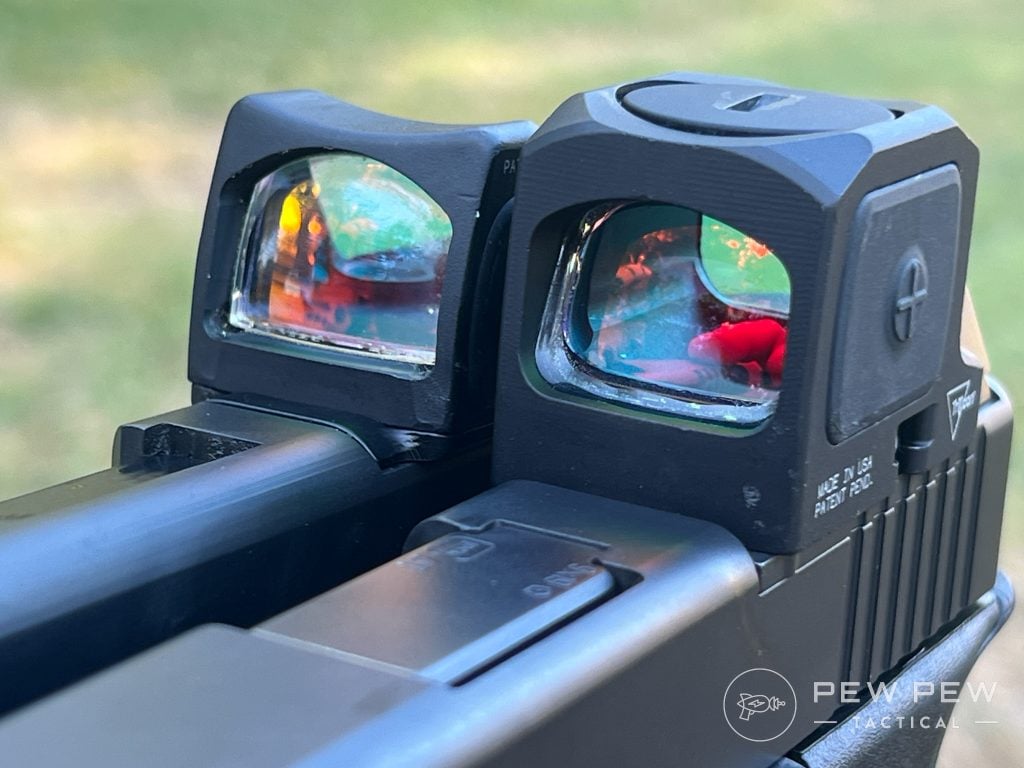
Internals
The features included in the RCR are as important as what are not. Its reticle is only currently available in red 3.25 MOA. While some companies are exploring other options, Trijicon is holding course with what is proven to work.
Brightness settings are key, though. There are 10 total, three dedicated to night vision. The lower two I couldn’t see with the naked eye but was able to view through night vision. Its top setting is so bright that I could easily pick it up while nearly pointing into the sun.
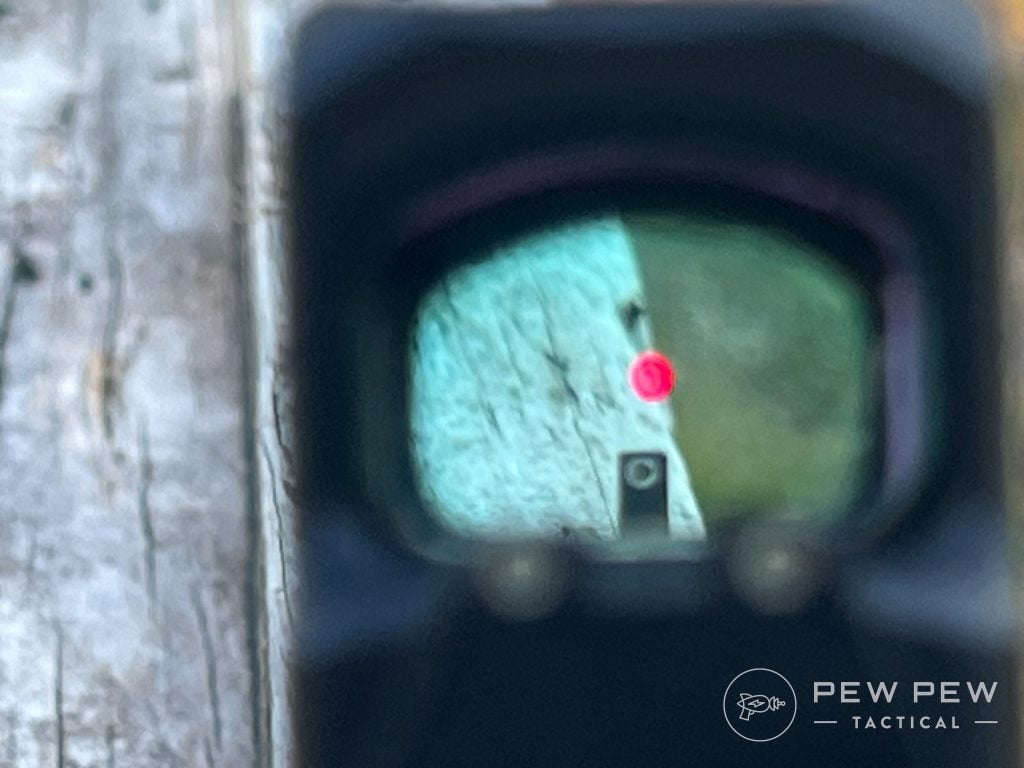
The auto-adjust brightness feature (of RMR fame) is gone. This is fine by me since any low-light scenario (shooting bright into dark or vice versa) will point out this feature’s weakness.
Rather, brightness settings are constantly in manual mode, requiring the user to select what they like with the push of a button and can be locked in. This intelligent design reflects the same reasoning behind the lack of a shake-awake option.
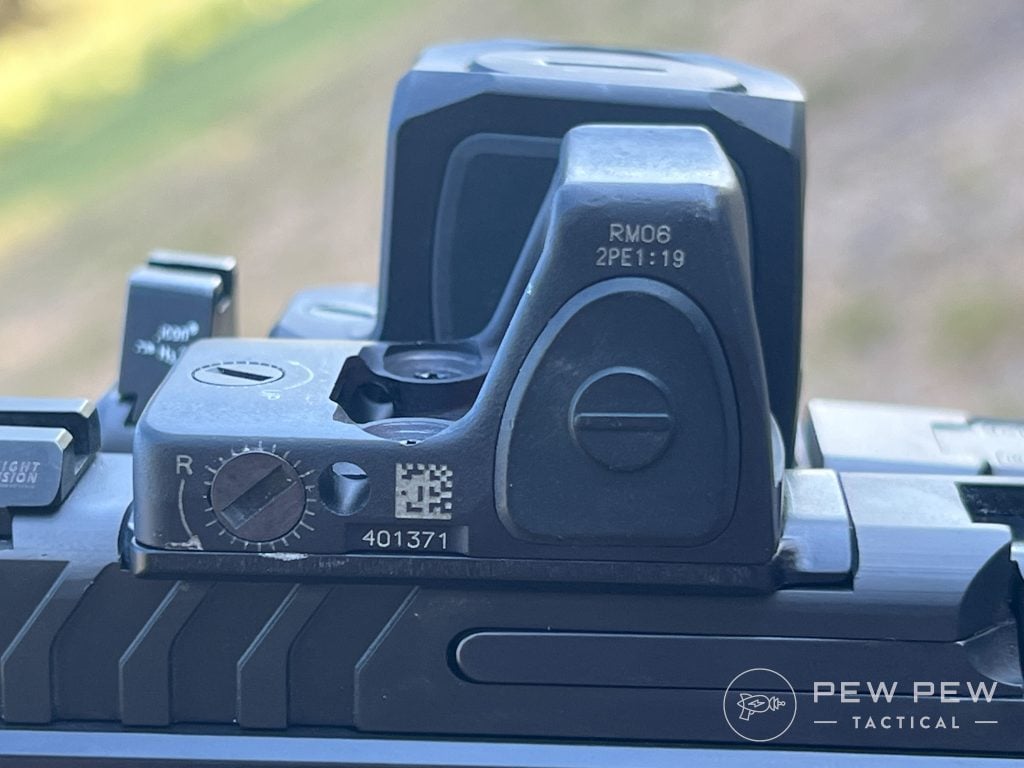
No, the RCR is on, stays on, and will be on at your last brightness setting until it runs out of CR2032 battery. And at brightness setting 5, this will take over six years to happen.
Externals
Trijicon closed the bottom of the RCR, increasing durability and waterproofing and evidencing further improvements from the RMR, which had a separate plate. They did this while maintaining the RMR footprint, a crucial element for compatibility.
The frame is built from 7075-T6 aluminum and utilizes the same deck height as the RMR. In addition, although the unit has a boxy appearance, all the corners are rounded off for protection.
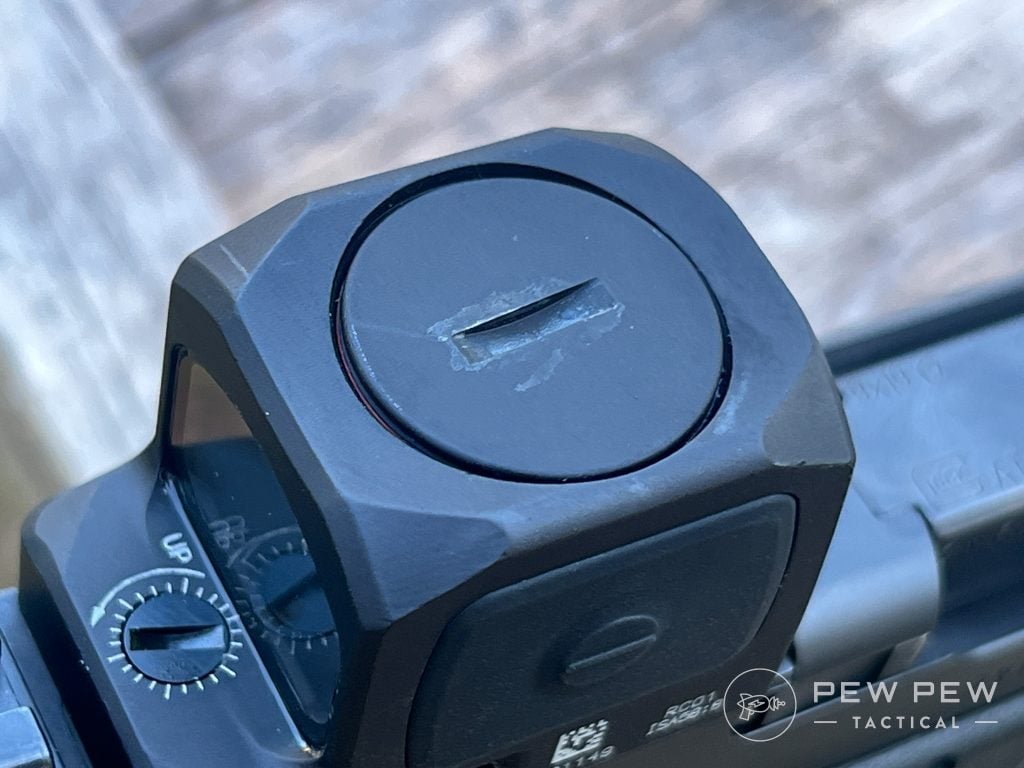
Trijicon wisely took the opportunity to kill another pain point from the RMR, the battery mount. Located on the top with an aluminum cap, shooters no longer have to remove the unit to change the battery.
Controls consist of giant rubber buttons adorning either side of the RCR. On the right, the dim button is indicated with a “-“ sign while a “+” to brighten is located on the left.
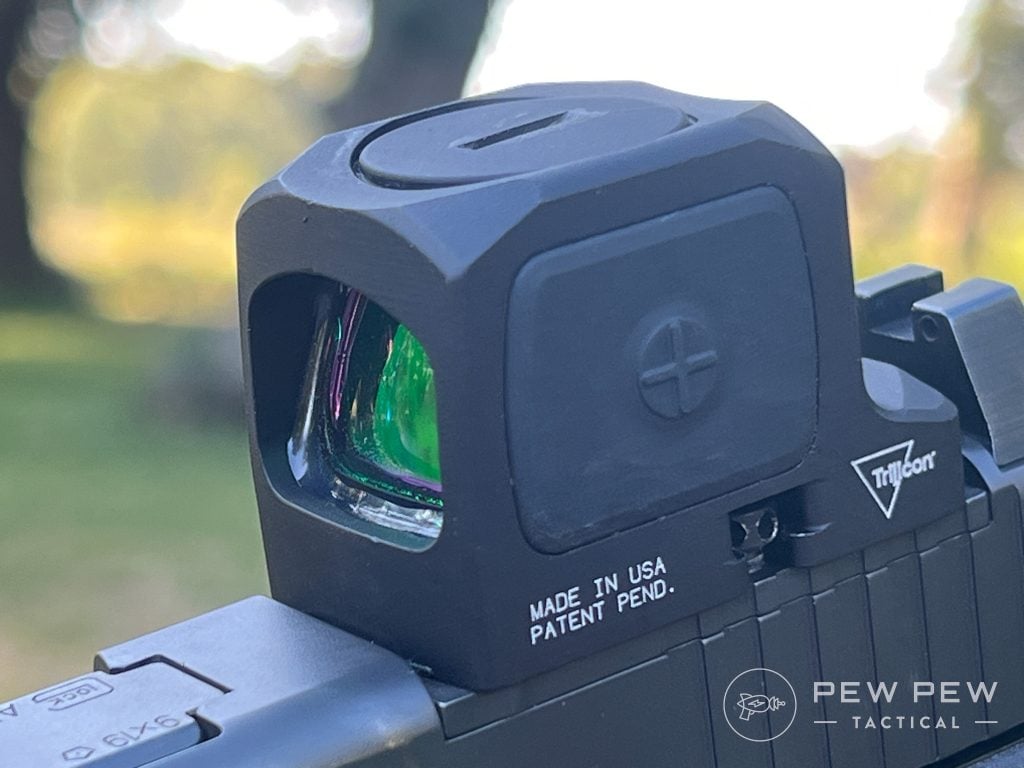
Zeroing is set up similarly to the RMR. Windage and elevation are handled on the right and rear, respectively, with screwdriver-adjustable dials.
Another improvement over the RMR is the mounting system. Utilizing capstan screws, these torque down the optic by applying pressure to the small holes in the side of the frame.
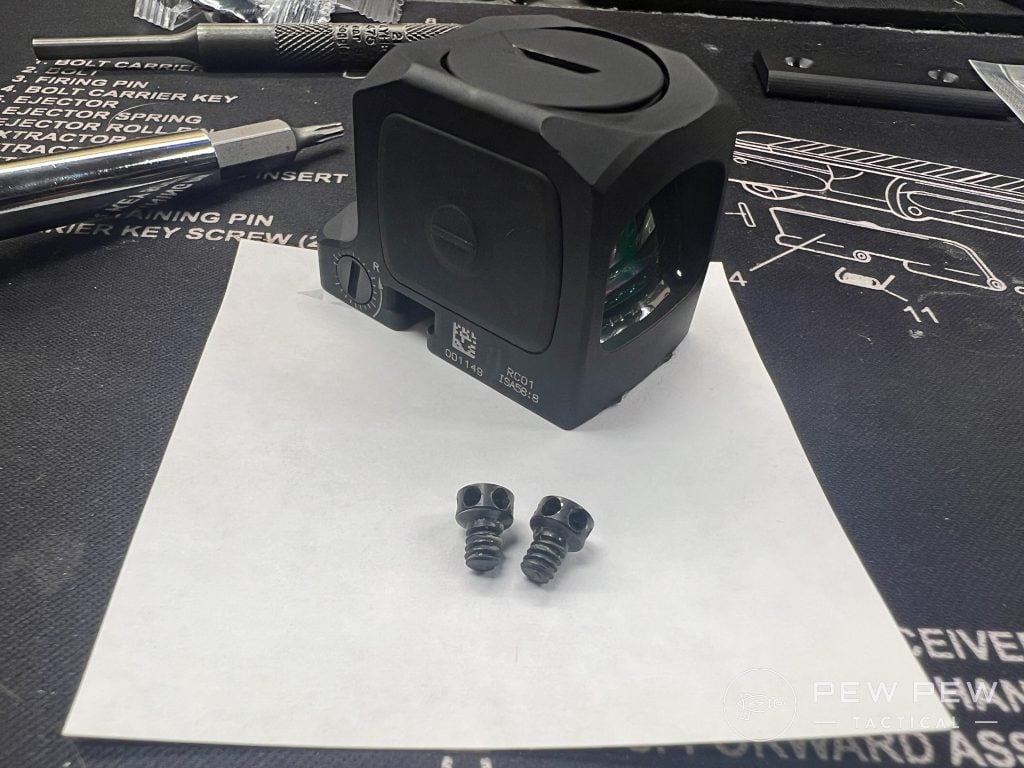
Finally, the RCR’s tempered glass is clear, features protective multi-coating, and is slightly smaller in front than the RMR, though the view-through seems almost the same.
Ergonomics
The overall impression of the RCR is somewhat boxy, though angular in ways that remind one of a stealth fighter. It feels light yet tough and supremely easy to use.
Adjusting brightness couldn’t be easier with the large buttons on either side. Even with gloves on, the rubber surfaces offer plenty of contact space.
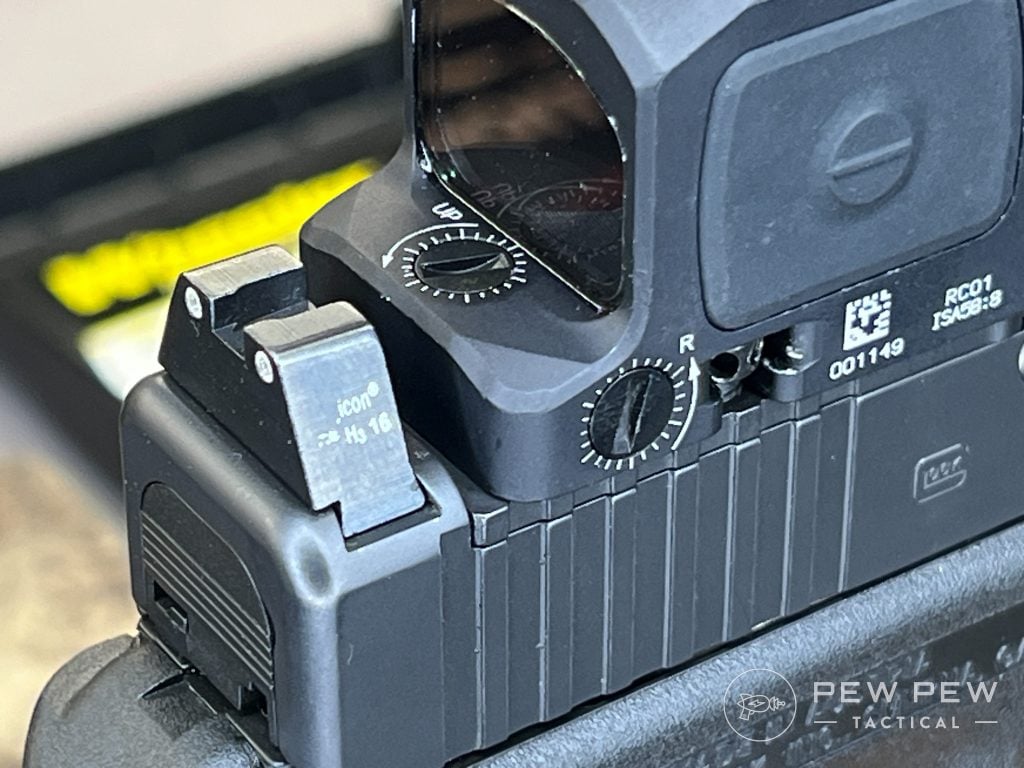
Zeroing is pretty easy, too. The adjustments are stiff enough not to get bumped easily, but they can be heard with light clicks (tougher for the shooting/hearing impaired).
Despite all this innovation, I was sincerely concerned that the mounting process would be difficult. It wasn’t too bad, particularly because there is a great step-by-step video.
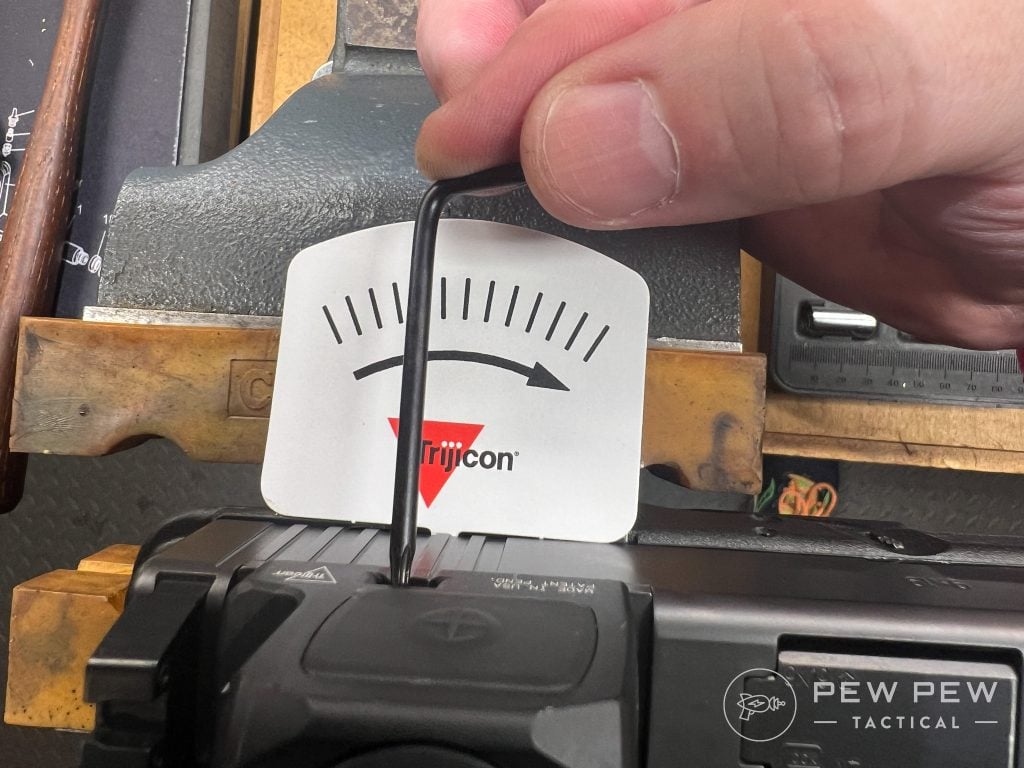
I found that the included tool didn’t fit overly well in the holes of the capstan screws. I used a tiny punch to start them, then finished with the included tool to torque to spec, according to the directions.
The final result is an incredibly solid fit that, I suspect, would weather far more abuse than I’d ever dish out.
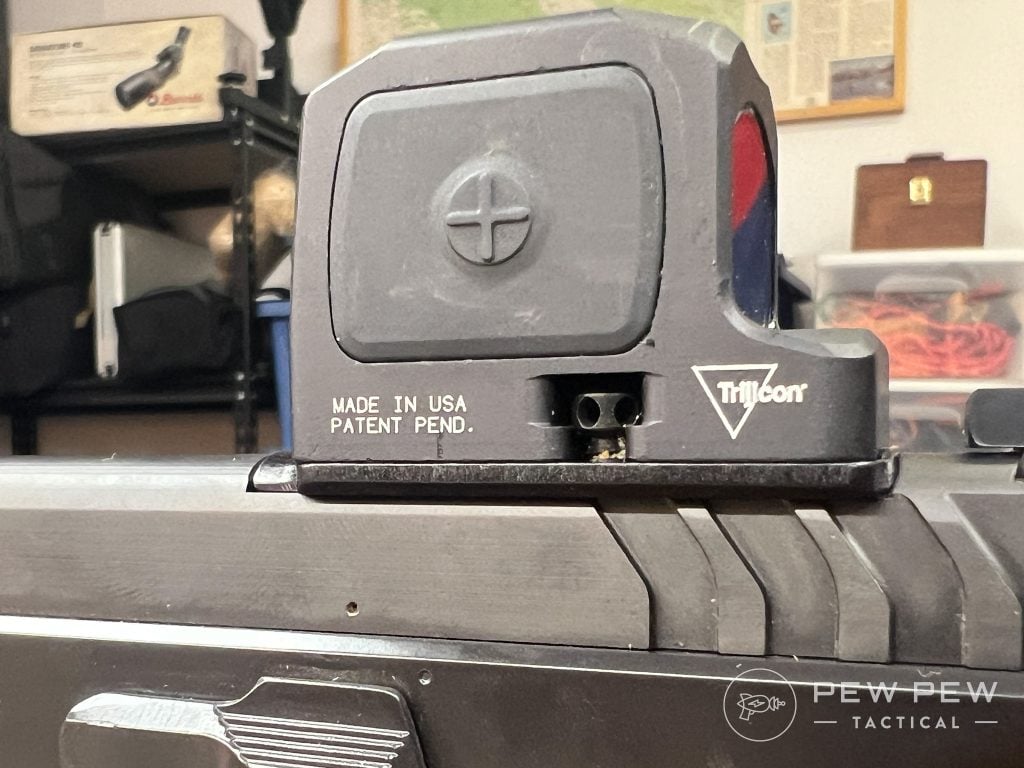
The overall bulk is quite a bit more than the RMR, and shooters should not assume that their holster will work with the RCR. I used the SafariVault for this review, and it fit perfectly.
Trijicon RCR View-Through
The RCR’s front glass is bigger than the RMR’s. However, the view-through appears to provide about the same sight picture.
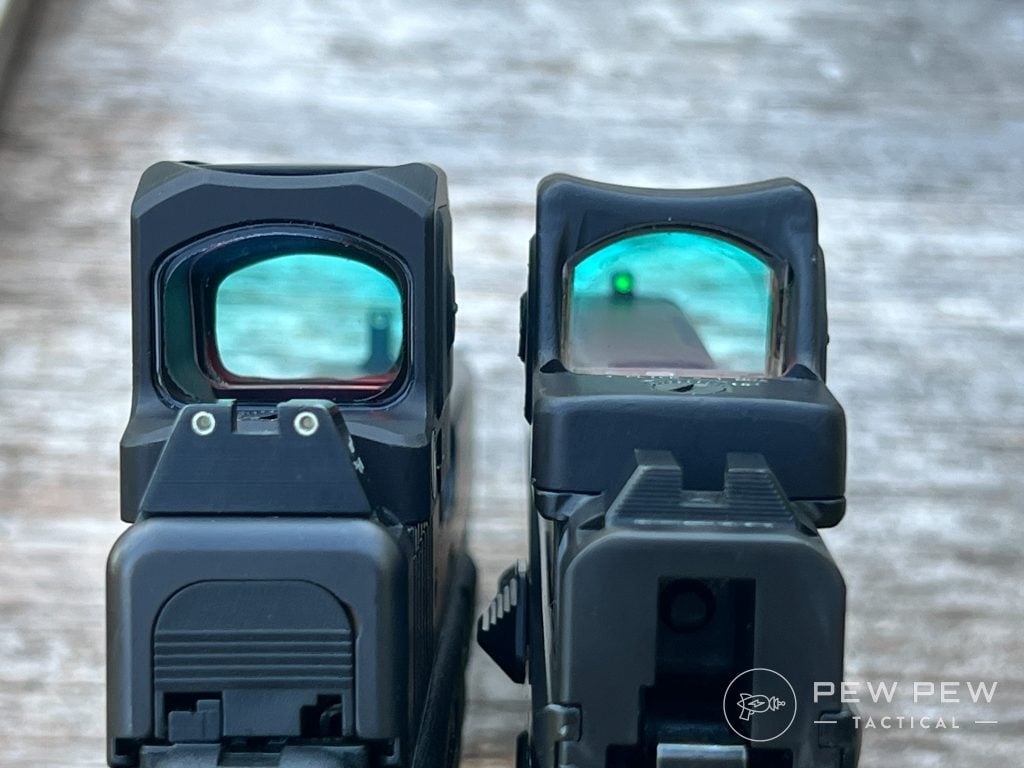
I suspect that some of the same coatings were used as the RMR because the blue tint I can see there is repeated in the RCR. The glass is clear and I detect less distortion with the RCR as well.
Having used the RMR on a duty weapon for years, the draw stroke and presentation were familiar to me. Although there is significantly more body around the RCR’s glass, I didn’t notice it.
When you focus on the target, not the dot, the RCR’s comparatively large size is less noticeable.
Who Is the Trijicon RCR For?
An optic this purpose-driven and at this price point is an easy justification for professional users. Its battery life and durability hold it poised to become yet another benchmark for pro shooters around the world.
However, it’s a tougher argument for casual shooters or home defenders when considering it is the price of another gun. Don’t get me wrong; it would excel in these roles and look great on the nightstand next to your monocle, top hat, and Cybertruck keycard.
By The Numbers
Affordability: 2/5
Granted, this is a top-of-the-line, enclosed emitter red dot. But at the price of $645, many shooters will find other options.
Looks: 3/5
Enclosed emitters look a bit clunky, like a crenelation on top of a castle. But like that structure, their form follows function.
Reliability: 5/5
While I did not abuse this optic, I wasn’t gentle with it either. Its performance during my testing and throughout all my research indicates that it is extremely solid.
Function: 5/5
The mounting system of the RCR is a cool departure that should prove rugged. On the range, the RCR is intuitive and capable of suffering hard use.
Overall: 3/5
The RCR is likely nearly bombproof and has top-notch electronics, but its price makes it a tough choice.
Prices accurate at time of writing
Prices accurate at time of writing
-
25% off all OAKLEY products - OAKLEY25
Copied! Visit Merchant
Final Verdict
Trijicon set the bar when they released the RMR in 2009, and the award-winning optic has been the subject of comparison ever since. History has repeated itself, but the RCR shows refinements: lessons learned and improvements made from experience.
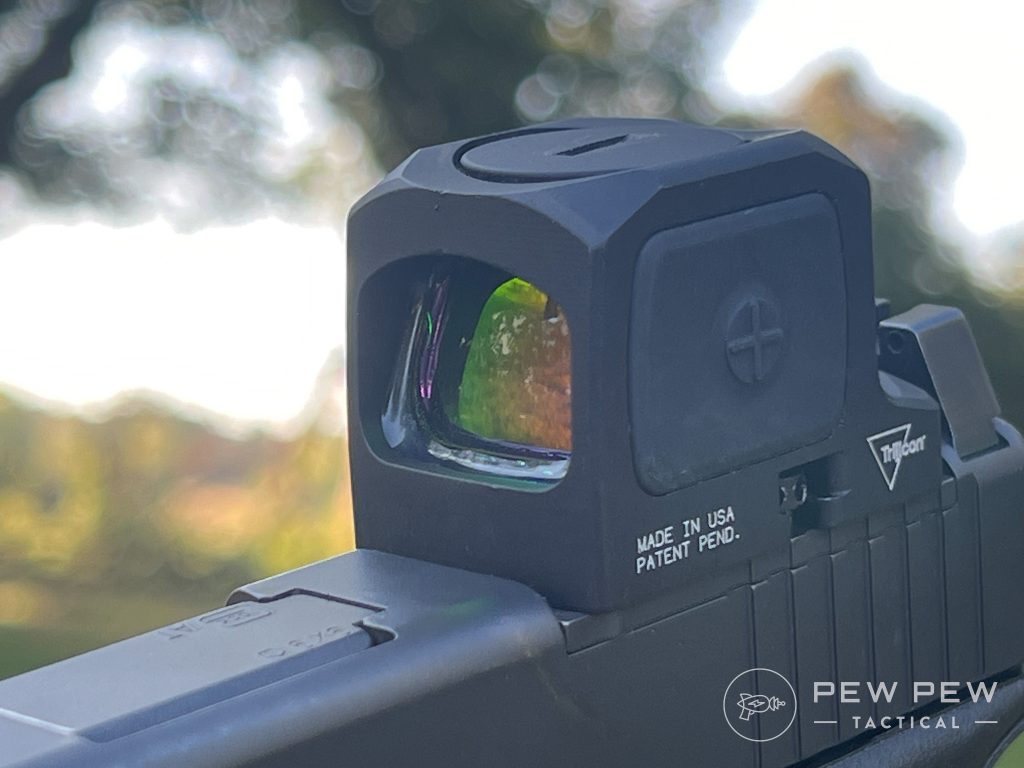
The RCR is not for everyone because of its price, but it is a top-shelf kit. If you have a need for an extremely durable, no-nonsense red dot that will probably outlive you, this is the choice.
What do you think of the Trijicon RCR? Let us know in the comments below. For more red dots, check out our guide to the Best Pistol Red Dots.

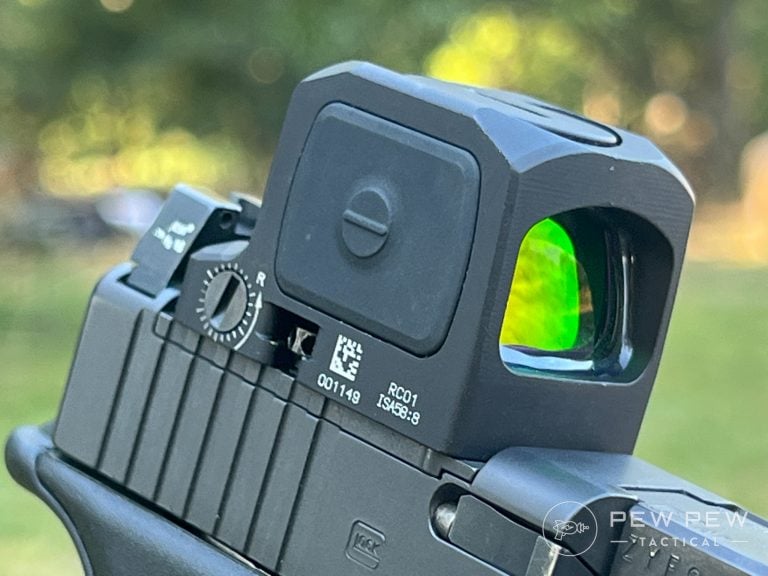
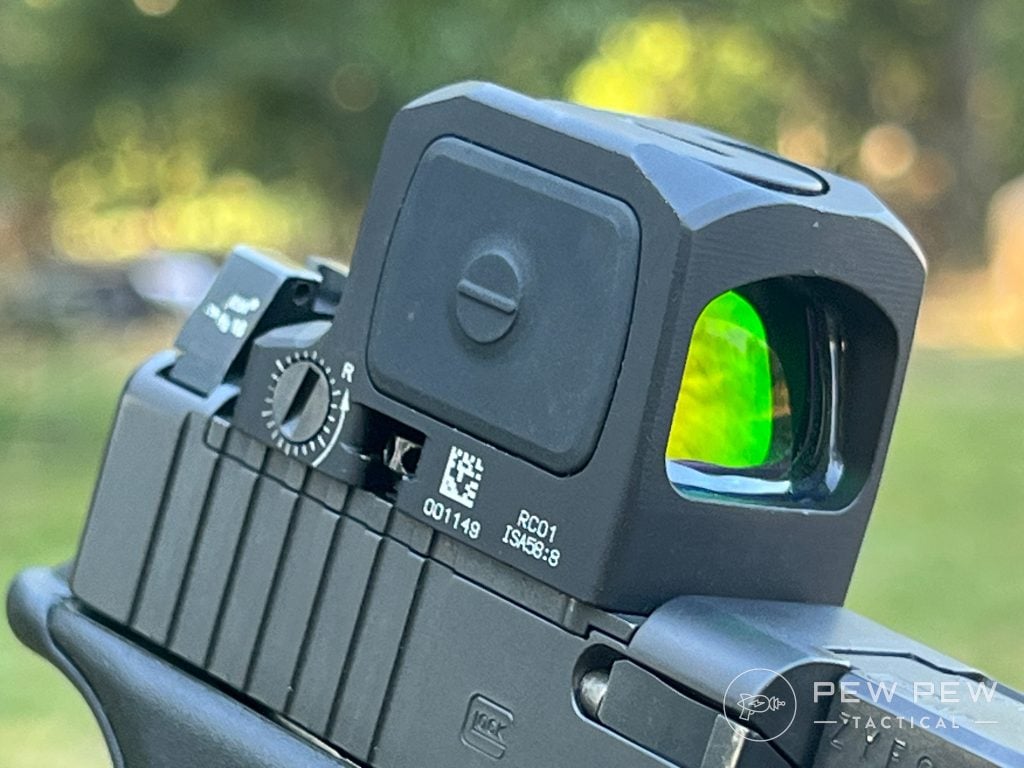







2 Leave a Reply
Hello All,
I missed an evolution sequence somewhere. Are closed Emitters necessary? I mean, and this is the part I missed, how often did our open emitters fail due to debris blocking the red light transmission?
I guess I cannot recall ever losing the dot due to mud, water, leaves or anything else blocking my dot.
Now here I’ll admit I did buy one. I’ve got the Holosun green circle dot closed emitter. It’s on 24/7. And it just works, all the time. It works so well that I’m not sure what I’d do if it didn’t. The reason I use the circle dot reticle is because of how well it works when shooting Steel Challenge. Most targets are round steel plates. Using a large out ring makes Steel Challenge SO FAST for my old eyes. When half my circle covers the round target and I’m swinging toward it so by the time I fire more than half the circle is covering the target. I don’t stop my swing I just keep going. I love circle dots. If you need accuracy you have the center dot. The big circle tells your eye where that little dot is. It’s just how our eyes work. I use a Ghost Ring on my stainless 45/70 for Moose Hunting. My eye naturally is drawn toward the red fiber optic post inside the Ghost Ring. Your eye naturally centers that red post/dot. I believe I drifted here, sorry.
I’m curious, how many readers have had issues with losing their dot from anything blocking its display on the window?
Thanks and Stay Safe.
Mark, I doubt you've missed anything. There are always going to be people who want more ruggedized gear, even if it's only a status indicator, not for the performance. I carried red dots on duty and never had any obstructions though by then I was out of the mud, blood, and beer. Enclosed emitters do have the advantage of not being blocked and they are arguably easier to clean. As to your question, no, they are not necessary.